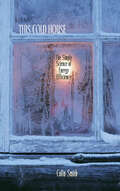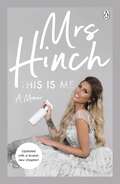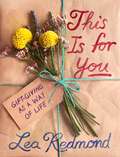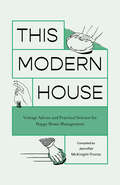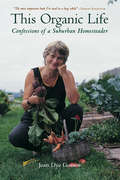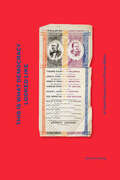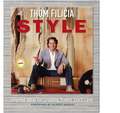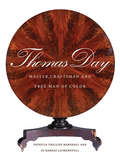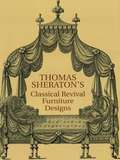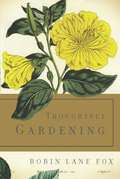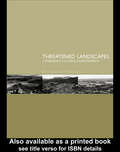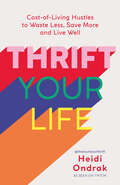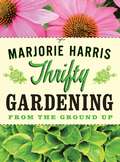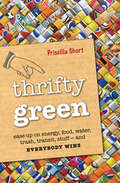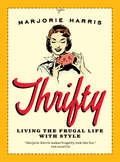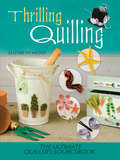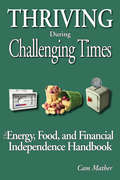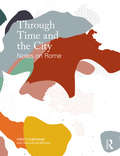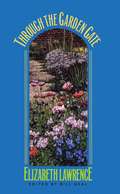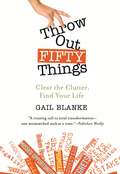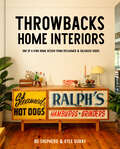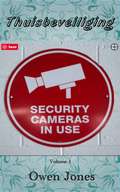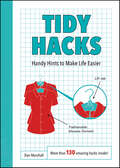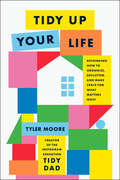- Table View
- List View
This Cold House: The Simple Science of Energy Efficiency
by Colin SmithA “witty, erudite, and accessible” guide to creating an environmentally friendly home without sacrificing comfort (Jeffrey C. May, author of My House Is Killing Me!).Does turning the thermostat down on a winter’s night offset the costs of reheating the house in the morning? What will best prevent energy loss: new windows or insulation in the attic? Is heating oil cheaper than natural gas?In This Cold House, Colin Smith blends science with anecdote and example to help homeowners identify heating and cooling priorities and choose the most appropriate methods, tools, and equipment. Basic equations allow you to estimate possible savings in annual heating and cooling bills and determine payback times for improvement projects.Practical and entertaining, This Cold House illuminates the concepts behind energy efficiency and translates them into ideas you can use, whether you live in a castle, igloo, or house.“Packs in important insights and is a pick for any general interest lending library catering to homeowners and those concerned with energy savings and the environment.” —Midwest Book Review“Smith . . . has a wonderful way with words, and his storytelling is superb. This guy sure knows how to hang an analogy on a scientific principle to make it delightfully understandable.” —Dan Holohan, heatinghelp.com
This Is Me: The No 1 Sunday Times Bestseller
by Mrs HinchGet to know the woman behind the Instagram cleaning sensation, Mrs Hinch, in her fascinating and remarkably honest memoir*** FEATURING A BONUS CHAPTER ABOUT THE BIRTH OF LENNIE ***THE SUNDAY TIMES NO. 1 BESTSELLER'Gut-wrenchingly honest' The Mail on Sunday'I love that woman so much, she is just so great' Rylan Clark-Neal, BBC Radio 2_____________I sometimes can't believe just how much has happened in the last couple of life-changing years. It's been a total whirlwind of a journey, and I'm so grateful to all my followers for their amazing love and support along the way.From my very first toy kitchen which was my pride and joy right through to the my very first Instagram posts stories of my cleaning routine, I'm going to take you back to the start of how it all began. But there is so much more to my story than just cleaning tips; there have been the highest of highs, but also heart-breaking devastating lows.So let's do this! Put your Hinch Lists to one side, get comfy and join me on the sofa with a cuppa. Welcome to my world.This is me: Soph - the wife, the mother and the person behind Mrs Hinch._____________'The sensation' Sun'We're mad about Mrs Hinch' Vogue'My new cleaning goddess' Daily Telegraph'Doing for household chores what Marie Kondo did for tidying' Daily Mirror'Mrs Hinch offers a reassuring structure for the day, a vision of domestic order' Guardian
This Is for You: Gift-Giving as a Way of Life
by Lea RedmondThe essential guide for gift-giving that makes our dearest feel loved and offers deep and lasting connection—from the author of the bestselling Letters to My Baby and creator of the “Letters to . . .” seriesRiddled with obligation, expense, and waste, gifts are often reduced in our consumeristic culture to products for purchase. We all want to give good gifts—but how?In This Is for You, artist and bestselling author Lea Redmond casts a vision for gift-giving as you’ve never seen it before. At their best, she proposes, gift-giving and receiving are an opportunity to practice relational care at every scale for the wellbeing of people and planet.“Gifts are relationships in miniature,” Redmond writes—a way to honor the spaces between us and practice the best of our humanity. Beyond the usual gift guide, This Is for You is a manifesto on open-hearted living that can enrich our relationships and awaken us to the world and its inherent abundance.With inspired ideas and stories that sparkle, Redmond empowers you to be generous in your kinkeeping, courageous in your connection, and surprised by your own capacity for creativity.Whether you’re searching for a great gift for a birthday, holiday, anniversary, wedding, or “just because,” This Is for You offers:Practical prompts for composing gift ideas your loved ones will cherishTips for surprises, wrapping, and wish lists that workCreative ideas for keeping within your budget as well as no-cost gift ideasPractical guidance on how to respond to an unwanted giftThis Is for You is delightfully illustrated with the author’s line drawings throughout.
This Modern House: Vintage Advice and Practical Science for Happy Home Management
by Jennifer Mcknight-TrontzThe time-tested advice you never learned in school for getting back to basics and running a healthy, happy, sustainable household.In this amazing collection of proven wisdom and practical advice from real vintage textbooks, you&’ll find everything you need to know about shopping, cooking, cleaning, budgeting, and managing a household like an adult—whether you&’re renting your first apartment or establishing a family home.Learn handy home management skills such as:• Replacing a button• Planning a dinner party• Choosing paint colors• Reducing food waste• Making natural cleaning supplies• And many, many moreGive your household a happier, healthier future with time-tested tips from the past!Previously published in 2010 as Home Economics, this fully updated version includes a new introduction and improved advice on cooking and canning.
This Organic Life
by Joan Dye GussowJoan Dye Gussow is an extraordinarily ordinary woman. She lives in a home not unlike the average home in a neighborhood that is, more or less, typically suburban. What sets her apart from the rest of us is that she thinks more deeply--and in more eloquent detail--about food. In sharing her ponderings, she sets a delightful example for those of us who seek the healthiest, most pleasurable lifestyle within an environment determined to propel us in the opposite direction. Joan is a suburbanite with a green thumb, with a feisty, defiant spirit and a relentlessly positive outlook. At the heart of "This Organic Life" is the premise that locally grown food eaten in season makes sense economically, ecologically, and gastronomically. Transporting produce to New York from California--not to mention Central and South America, Australia, or Europe--consumes more energy in transit than it yields in calories. Add in the deleterious effects of agribusiness, such as the endless cycle of pesticide, herbicide, and chemical fertilizers; the loss of topsoil from erosion of over-tilled croplands; depleted aquifers and soil salinization from over-irrigation; and the arguments in favor of "this organic life" become overwhelmingly convincing. Joan's story is funny and fiery as she points out the absurdities we have unthinkingly come to accept. Joan has discovered ways to nourish herself, literally and spiritually, from her own backyard. If you are looking for a tale of courage and independence in a setting that is entirely familiar, read her story.
This is What Democracy Looked Like: A Visual History of the Printed Ballot
by Alicia ChengThis Is What Democracy Looked Like, the first illustrated history of printed ballot design, illuminates the noble but often flawed process at the heart of our democracy. An exploration and celebration of US ballots from the nineteenth and early twentieth centuries, this visual history reveals unregulated, outlandish, and, at times, absurd designs that reflect the explosive growth and changing face of the voting public. The ballots offer insight into a pivotal time in American history—a period of tectonic shifts in the electoral system—fraught with electoral fraud, disenfranchisement, scams, and skullduggery, as parties printed their own tickets and voters risked their lives going to the polls.
Thom Filicia Style
by Thom Filicia"I'm a democratic design snob. I see it as my mission to help stamp out boring, unimaginative interiors. But I also love people, having fun, and what I do for a living. I think a fabulously styled place is achievable by everyone. Think of me as your decorating wingman." Thom Filicia, whose one-of-a-kind makeover genius gained national attention through his starring roles on Queer Eye for the Straight Guy and Dress My Nest, offers the ultimate handbook for creating gorgeous interiors that showcase your unique personal style. Those who have witnessed Thom's remarkable makeovers on television already know about the much-anticipated reveal moment when the emotionally overwhelmed homeowners are struck speechless by the miracle he has created. The same miracle is now possible for your home, with the secrets and tips contained in Thom Filicia Style. With his trademark wit and friendly voice, Thom deconstructs how he works his magic and provides pages of invaluable advice, inspiration, before-and-after photos, case studies, floor plans, and product information. His approach will help you elevate your personal aesthetic by strategizing the best ways to make the most out of every space. From his work on a Manhattan loft to a suburban family home, Thom brings a fresh and invigorating vision to the way we live -- a vision that can apply to homes and decorating budgets of any size. Demystifying the decorating process one step at a time, Thom has filled this guide with everything you need to create the perfect interior. Thom Filicia Style is like having the designer himself on hand to take care of all the details.
Thomas Day: Master Craftsman and Free Man of Color
by Patricia Phillips Marshall Jo Ramsay LeimenstollThomas Day (1801-61), a free man of color from Milton, North Carolina, became the most successful cabinetmaker in North Carolina--white or black--during a time when most blacks were enslaved and free blacks were restricted in their movements and activities. His surviving furniture and architectural woodwork still represent the best of nineteenth-century craftsmanship and aesthetics. In this lavishly illustrated book, Patricia Phillips Marshall and Jo Ramsay Leimenstoll show how Day plotted a carefully charted course for success in antebellum southern society. Beginning in the 1820s, he produced fine furniture for leading white citizens and in the 1840s and '50s diversified his offerings to produce newel posts, stair brackets, and distinctive mantels for many of the same clients. As demand for his services increased, the technological improvements Day incorporated into his shop contributed to the complexity of his designs. Day's style, characterized by undulating shapes, fluid lines, and spiraling forms, melded his own unique motifs with popular design forms, resulting in a distinctive interpretation readily identified to his shop. The photographs in the book document furniture in public and private collections and architectural woodwork from private homes not previously associated with Day. The book provides information on more than 160 pieces of furniture and architectural woodwork that Day produced for 80 structures between 1835 and 1861. Through in-depth analysis and generous illustrations, including over 240 photographs (20 in full color) and architectural photography by Tim Buchman, Marshall and Leimenstoll provide a comprehensive perspective on and a new understanding of the powerful sense of aesthetics and design that mark Day's legacy.
Thomas Sheraton's Classical Revival Furniture Designs
by Thomas SheratonElegant 18th-century style book that was immediately successfully in England, Russia, America, British India. Complete coverage of Sheraton's most important designs: clock cases, commodes, drawing tables, library steps, chairs, other items. 98 plates.
Thoughtful Gardening
by Robin Lane FoxIn Thoughtful Gardening, award-winning historian and Financial Times gardening columnist Robin Lane Fox takes readers on a delightful journey through each season of the gardening year. From fending off vine-weevils to visiting Yves Saint Laurent’s private gardens in Marrakech, Fox imbues each of his musings with grace, sophistication, and charm. Essential reading for anyone planting a new garden or taking stock of one after several years, Thoughtful Gardening offers expert advice and a touching reminder of the power of art and literature to deepen what we see and experience in nature. Combining a vast understanding of horticulture with witty and stylish storytelling, these vignettes form--season by season--a rich reflection on the lessons, challenges, and joys of life with a green thumb.
Threatened Landscapes: Conserving Cultural Environments
by Bryn Green Willem VosFew, if any, environments are free of human intervention. Often this generates ecosystems which are rich in biodiversity, historical interest, recreational opportunity and scenic beauty just as worthy of conservation as the more natural ecosystems on which protection programmes have been almost exclusively focussed.These 'cultural landscapes', ranging from the farm and forest lands of Europe and Eastern North America, through to the pasture lands and savannas of the Middle East and Africa to the paddylands of the Pacific Rim, are usually the product of relatively low-level, sustainable exploitation of the environment over long periods of time. Many have survived for centuries, if not millennia, but now urban expansion, depopulation of rural areas and, most damagingly, the intensification of agricultural and sylvicultural practices, are everywhere leading to a loss of their cherished biodiversity and amenity. Whilst past changes have mostly added to the valued characteristics of these landscapes, modern farming and forestry are creating sterile monocultures on the better land whilst marginal lands are being abandoned.This book documents these changes, illustrates them through detailed case studies of a representative selection of threatened landscapes, analyses their underlying causes and explores ways by which they can continue to be maintained, or new landscapes created which maintain their desired characteristics.
Thrift Your Life: Cost-of-Living Hustles to Waste Less, Save More and Live Well
by Heidi OndrakThe Queen of Thrift.' The Sun 'Super Saver Mum shares simple tips.' Daily MailFull of hacks and hustles to navigate those sudden changes in fortune that none of us could have predicted. This is a no-nonsense guide on how to change your habits to weather the storm, written by TikTok's queen of budgeting, Heidi Ondrak, aka The Duchess of Thrift.Life rarely follows a linear path, sh*t happens that you could have controlled better, and then stuff happens that you have absolutely no control over whatsoever, like the current cost-of-living crisis. Full of practical hacks to adapt to life's financial ups and downs and guaranteed to help you save every month, Heidi will show you how to nurture resilience alongside some of those cheeky life hacks that no one teaches in schools. Think of it as a modern-day take on Mrs Beeton's Book of Household Management, with extra sass.Hacks range from the well-versed and practical to the downright outrageous – pick and choose, do what suits you. Heidi will help you build a toolkit to get you through the crisis and feel prepared and in control for more energy increases, interest rate rises and eye-watering inflation, while doing it with a fighting spirit and sunny demeanor. You'll learn how to change your mindset, get the family on board, carry out budget health checks, shop smarter, look a million dollars for pennies, have great days out, enjoy Xmas and be able to get around... All on a shoestring!
Thrifty Gardening: From the Ground Up
by Marjorie HarrisBestselling author and gardening columnist Marjorie Harris offers a timely and entertaining guide for gardeners at every stage of life. Whether you're moving into your first apartment or condo, upgrading to a house, or downsizing to smaller digs, Harris shares the best tips on how to create a beautiful garden for any space — all on a budget. The highly anticipated sequel to her popular book Thrifty: Living the Frugal Life with Style, The Thrifty Gardener marries Harris's passion for gardening with her thrifty lifestyle savvy so that everyone can create a natural oasis whatever their living situation is — and without breaking the bank.
Thrifty Green: Ease Up on Energy, Food, Water, Trash, Transit, Stuff—and Everybody Wins
by Priscilla ShortHow one woman&’s year living off the grid made her think about conservation in a whole new way—and how to apply what she learned to your own lifestyle. Priscilla Short lived off the grid for a year in a strawbale house in Taos, New Mexico, with no electricity, no running water, and a wood-burning stove for heat. At the end of the year, Short returned home to Denver committed to making a smaller ecological footprint by consuming less and conserving more. In Thrifty Green, Short offers a unique, resource-by-resource approach that shows us that the best way to practice conservation, the real win-win, involves saving money as we lighten up. This book will help you make crucial decisions about transportation, heat, power, light, water, food, and garbage. Peppered with examples of people living both on and off the grid, eccentric and ordinary, who are deliberately making choices to live with less, Thrifty Green is much more than a how-to book. It is a conscientious guide to the art of going green that includes a wealth of terrific tips, fun facts, and straightforward strategies that will make you think about conservation in a whole new way.
Thrifty: Living the Frugal Life with Style
by Marjorie HarrisWritten in Marjorie Harris's trademark witty, engaging, and accessible style, Thrifty is chock-full of simple and savvy tips drawn from her own richly thrifty experience, and those of renowned experts such as bestselling author Margaret Atwood, actor R. H. Thomson, travel writer Sylvia Fraser, and the Globe and Mail Style columnists. With solid tips on how to haggle, how to become a frugal fashionista, maintaining home and hearth on a budget, and practical advice on thrifty gardening, travel, and entertainment, Harris provides essential guidelines to living a quality life on less.
Thrilling Quilling: The Ultimate Quiller's Sourcebook
by Elizabeth Moad"This book is an excellent sourcebook for quilling and I recommend anyone interested in paper craft to own this book." -- Doodles in the Margin ReviewsAdd pizzazz to picture frames, notebooks, vases, boxes, bags, or any everyday item that could use a decorative touch. The centuries-old craft of quilling involves rolling, shaping, and gluing strips of paper into ornamental designs. It's easy to learn, and this guide is bursting with simple, step-by-step instructions and colorful illustrations that will get you started and send you on your way with a wealth of new possibilities.From quick and easy individual motifs to larger, more elaborate combinations, here are more than 100 designs with countless applications. Quilling requires very little equipment and few materials -- just an inexpensive investment in a manual quilling tool, glue, and paper. With a little practice, you'll master the techniques of coiling, pinching, fringing, weaving, and husking. Then you'll be able to add a personal touch to cards, gifts, and other items. In addition, the book features galleries of imaginative ideas that will provide further inspiration and encourage you to develop new ideas and creative approaches.
Thriving During Challenging Times
by Cam MatherMost of us have never lived through times as tough as these. The economic crisis, peak oil, rising food costs, climate change, and water shortages have all converged to make it a very challenging time. This book provides a road map to allow you to return to the independence of previous generations: independence in how you power your home, where you get your food from, and how you control your financial destiny. The amazing thing is that the recommendations are not only good for you, they're good for the planet. Showering with water heated by the sun and eating a "one hundred foot diet" with food grown in your backyard will help you to reduce your carbon footprint. They also give you back control of your budget. By using the step-by-step guide on how to get the fastest payback and invest the money you save, you'll discover the joy of being in control again.From where you live, to how you heat and power your home, to producing your own food, controlling water, and getting your financial house in order, this book proves that money doesn't buy happiness, but using what you have wisely helps.Because most of the recommendations are good for your health, good for the health of the planet, and good for your finances, the book sets out a win/win/win scenario. Challenging times provide a tremendous opportunity for personal growth while giving your soul the joy to return to a saner pace in your life.
Through Time and the City: Notes on Rome
by Kristi Cheramie Antonella De MichelisThrough Time and the City: Notes on Rome offers a new approach to exploring cities. Using Rome as a guide, the book follows familiar sites, geographies, and characters in search of their role within a larger narrative that includes the environmental processes required to generate enough space and material for the city, the emergent ecologies to which its buildings play host, and the social patterns its various structures help to organize. Through Time and the City argues that Rome is made and unmade by an endlessly evolving chorus that has, for better or worse, gained geological legitimacy; that the city absorbs and emits countless artifacts in its search for collective identity; that the city is a platform for the constant staging of negotiations between agents (humans, buildings, plants, animals, pathogens, goods, waste, water) that drive and are driven by the entanglements of climate and culture. This book provides textual and visual frameworks for identifying the material traces, emergent patterns, or speculated futures that expose a city as inseparable from its capacity to change.
Through the Garden Gate
by Elizabeth Lawrence Bill NealThrough the Garden Gate is a collection of 144 of the popular weekly articles that Elizabeth Lawrence wrote for The Charlotte Observer from 1957 to 1971. With those columns, a delightful blend of gardening lore, horticultural expertise, and personal adventures, Lawrence inspired thousands of southern gardeners. "[A] fine contribution to the green-thumb genre.--Publishers Weekly
Throw Out Fifty Things: Clear the Clutter, Find Your Life
by Gail BlankeAccording to Real Simple columnist Gail Blanke, "Our lives are so filled with junk from the past-from dried up tubes of crazy glue to old grudges-that it's a wonder we can get up in the morning, never mind to work, care for our children, our parents and just put one foot in front of the other." Blanke wants to start a movement of people across America throwing out fifty things (magazines count as only one!) that will help liberate us from the stuff-both physical and mental-that clutters our lives. It is the physical stuff that keeps us from being happy and calm in our house - not to mention keeps us from finding our keys in the morning! And it is the clutter in our mind that drags us down and holds us back from living the life we want to live. Blanke will take the reader through each room in the house and help her figure out what to throw out that will help them move forward. She'll show us how to find and throw out "toxic" possessions that remind us of failed relationships, bad jobs, etc, and she'll help us figure out what to keep to help us find out who we really are. Blanke's motivational advice in this book will inspire thousands of readers to take action as do her popular columns in Real Simple and her work as a life coach for Fortune 500 companies.
Throwbacks Home Interiors: One of a Kind Home Design from Reclaimed and Salvaged Goods
by Bo Shepherd Kyle DubayA stunningly photographed collection of homes featuring sustainable designs that celebrate the ingenuity of reclaimed materials and unexpected antiques, from the founders of Detroit-based furniture design brand Woodward Throwbacks.In an effort to celebrate the unique and beautiful material that is often scrapped in renovations Bo Shepherd and Kyle Dubay founded Woodward Throwbacks, which creates original furniture and home goods using reclaimed materials salvaged in Detroit. In Throwbacks Home Interiors, they dive into the creativity of home salvage, showing readers how to incorporate found and reclaimed materials into their home décor and furniture. Each chapter showcases inspiration for incorporating salvaged materials into your home in new ways, includingUpscale furnishings made from unexpected materials, like old signs turned into a credenzaWays to incorporate original hardware, flooring, or trim into any style, whether you prefer a more traditional look, a modern sleek design, or an eclectic mix.Spotlights on various materials and how to include them in your home, whether that's using a marble remnant to make a brand new countertop, turning broken tiles into a bespoke backsplash, or using offcuts of wood to create a one of a kind gorgeous side table.Tips for finding salvaged and reclaimed material as well as insights into thrifting furniture and finding old things to love in your new home.Along the way, authors Bo Shepherd and Kyle Dubay give readers the tools to bring that unique style home. For fans of historic details and homes with a story, Throwbacks Home Interiors offers plenty of inspiration for reusing, restyling, and elevating items that you find or love, matching modern with antique for a home that is stylish and personal.
Thuisbeveiliging: Volume 1 (Hoe te... #33)
by Owen JonesThuisbeveiliging Volume 1 De informatie in dit e-boek over de verschillende aspecten van het beschermen van uw familie en huis en vergelijkbare ideeën is georganiseerd in 15 hoofdstukken van ongeveer 500-600 woorden. Ik hoop dat het de mensen interesseert die zich zorgen maken over hun veiligheid. Als een toegevoegde bonus geef ik u toestemming om de inhoud op uw website, blogs en nieuwsbrieven te gebruiken. Echter is het beter om het eerst in uw eigen woorden te zetten. U mag ook het boek in delen opsplitsen en de artikelen los doorverkopen. Het enige recht dat u niet heeft is het herverkopen of weggeven van het boek in de wijze dat hij aan u is geleverd.
Tidy Hacks: Handy Hints to Make Life Easier
by Dan MarshallOver 100 quick tricks and shortcuts to clean up and keep your clutter under control—includes illustrations!Discover ingenious ways to clean and organize your house and your life with this inspired guide from the author of Life Hacks and Dad Hacks. Hackmaster Dan Marshall provides tricks, shortcuts, and ideas to help solve everyday annoyances—including ways to reuse, recycle, and reclaim your space from creeping clutter.Don’t throw away those breakfast grapefruit halves—add a little salt and use them to clean your oven. Is space tight in the bathroom? Use hanging tiered fruit and vegetable baskets from the shower rod to stow your stuff. Tidy Hacks includes dozens and dozens of illustrated tips for every area of your home (and more), including:Kitchen * Bathroom * Bedroom * Laundry * Garden * Home Office * Closets * Electronics * Kids’ Play Areas * Jewelry and Accessories * Shoes * Storage * and more
Tidy Up Your Life: Rethinking How to Organize, Declutter, and Make Space for What Matters Most
by Tyler MooreBring order to your home and focus to your busy life with Tidy Dad&’s guiding principles and practical routines for organizing, cleaning, and prioritizing—both emotionally and physically.A father of three with a stressful job, Tyler Moore felt his life resembled an overstuffed closet: disorganized and overly busy behind tidy, closed doors. When it all became too much—for his family's 750-square-foot apartment and his mental health—he set out to unpack the physical and emotional mess around him.Chronicling his progress as &“Tidy Dad&” on Instagram, Moore learned that tidying is about so much more than the aesthetics and decluttering of a physical space. When he stepped back, reflected, and named what was "just enough," he was able to devise systems and hacks that brought order to his whole life. Drawing on Moore's experience with the everyday highs and lows of parenting, home management, and work-life balance, and filled with his signature warmth and wit, Tidy Up Your Life includes: Tidy Dad&’s process for tackling overwhelming tasks—how to identify what really matters both emotionally and physically to you and the people who share your space. How to arrive at your own definition of "just enough" as well as thought experiments for appreciating what you already have.The goal is not "always tidy" but "easily tidied" and other principles for lifting some of the mental and physical burdens we feel when managing our homes. Tips for making a &“one-area-a-weekday&” cleaning schedule and other simple routines that compliment household rhythms and reduce the mental load you may be carrying.A vital book for overwhelmed parents as well as overworked, stressed-out professionals, Tidy Up Your Life will help you live a more joyful, tidied-up life.
